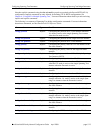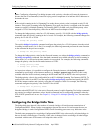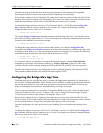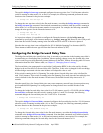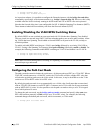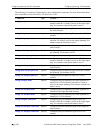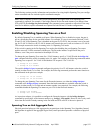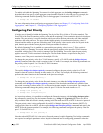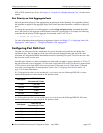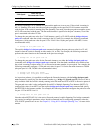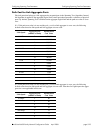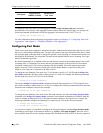
Configuring Spanning Tree Parameters Configuring Spanning Tree Port Parameters
OmniSwitch 6600 Family Network Configuration Guide April 2006 page 5-19
Configuring Spanning Tree Port Parameters
The following sections provide information and procedures for using CLI commands to configure STP
port parameters. These parameters determine the behavior of a port for a specific VLAN Spanning Tree
instance (1x1 STP mode) or for a single Spanning Tree instance applied to the entire switch (flat STP
mode).
When a switch is running in the 1x1 STP mode, each VLAN is in essence a virtual STP bridge with its
own STP instance and configurable parameters. To change STP port parameters while running in this
mode, a VLAN ID is specified to identify the VLAN STP instance associated with the specified port.
When a switch is running in the flat Spanning Tree mode, VLAN 1 is specified for the VLAN ID. It is
possible to configure STP parameters on other VLANs while running in this mode, but only VLAN 1
parameter values apply to all Spanning Tree ports.
Only bridged ports participate in the Spanning Tree Algorithm. A port is considered bridged if it meets all
the following criteria:
• Port is either a fixed (non-mobile) port, an 802.1Q tagged port or a link aggregate logical port.
• Spanning tree is enabled on the port.
• Port is assigned to a VLAN that has Spanning Tree enabled.
• Port state (forwarding or blocking) is dynamically determined by the Spanning Tree Algorithm, not
manually set.
Bridge Configuration Commands Overview
Spanning Tree port commands are available in an implicit form and an explicit form. Implicit commands
resemble commands that were previously released with this feature. The type of instance configured with
these commands is determined by the Spanning Tree operating mode that is active at the time the
command is used. For example, if the 1x1 mode is active, the instance number specified with the
command implies a VLAN ID. If the flat mode is active, the single flat mode instance is implied and thus
configured by the command.
Explicit commands introduce three new keywords: cist, 1x1, and msti. Each of these keywords when used
with a port command explicitly identify the type of instance that the command will configure. As a result,
explicit commands only configure the type of instance identified by the explicit keyword regardless of
which mode (1x1 or flat) is active.
The cist keyword specifies the Common and Internal Spanning Tree (CIST) instance. The CIST is the
single Spanning Tree flat mode instance that is available on all switches. When using STP or RSTP, the
CIST is also known as instance 1 or bridge 1. When using MSTP (802.1s), the CIST is also known as
instance 0. In either case, an instance number is not required with cist commands, as there is only one
CIST instance.
The 1x1 keyword indicates that the instance number specified with the command is a VLAN ID. The msti
keyword indicates that the instance number specified with the command is an 802.1s Multiple Spanning
Tree Instance (MSTI).
Note that explicit commands using the cist and msti keywords are required to define an MSTP (802.1s)
configuration. Implicit commands are only allowed for defining STP or RSTP configurations. See
Chapter 6, “Using 802.1s Multiple Spanning Tree,” for more information about these keywords and using
implicit and explicit commands.





